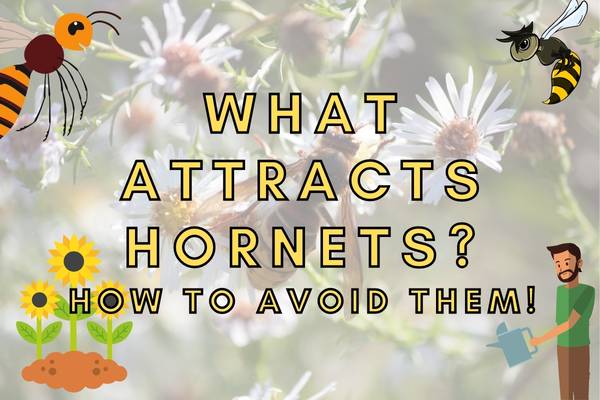Gorillas are one of the largest apes and are mainly found in central Africa. Gorillas live in family groups led by a silverback male and consisting of females and their offspring. These families travel together through the dense rainforests looking for food.
Gorillas are primarily herbivores but sometimes act as omnivores, which means that they eat both plants and animals. Gorillas eat a lot of plant material but they also eat a few insects. While gorillas may eat meat when fed to them in the zoo, they are not considered carnivores in the wild.
Although gorillas are technically omnivores, they are mostly herbivorous, eating leaves, stems, bark, flowers, and fruits. They also eat insects and small vertebrates, but only rarely.
Gorillas are mostly vegetarian, eating leaves, stems, berries, and other plant parts. They also eat some insects, such as ants and termites.
Gorillas live in Africa and eat what is available in their habitat. If they live in an area with lots of fruits and vegetables, they will eat more fruits and vegetables. If they live in an area with more bamboo, they will eat more bamboo.
Contents
When Do Gorillas Eat Meat?
Gorillas, fascinating creatures that they are, primarily thrive on a plant-based diet. Their dietary preferences primarily consist of fruits, leaves, stems, shoots, and other vegetation found in their natural habitats. However, it is extremely rare for gorillas to consume other animals, as they are primarily herbivores with a limited carnivorous inclination.
Gorillas can act as carnivores, but do so rarely. Gorillas have been known to eat meat on occasion when plant food is scarce or if they happen to encounter a weak animal or a fresh carcass.
But more commonly, they act as carnivores when they eat insects like termites as shown in the video below.
They do not actively hunt though, and would never attack larger animals for food.
Gorillas are primarily herbivorous primates belonging to the family Hominidae. They are closely related to humans and share common ancestors, but their feeding habits diverged from ours over time. As an expert on primatology, I have had the privilege of studying gorillas in their natural habitats, observing their behavior, and delving into their dietary patterns.
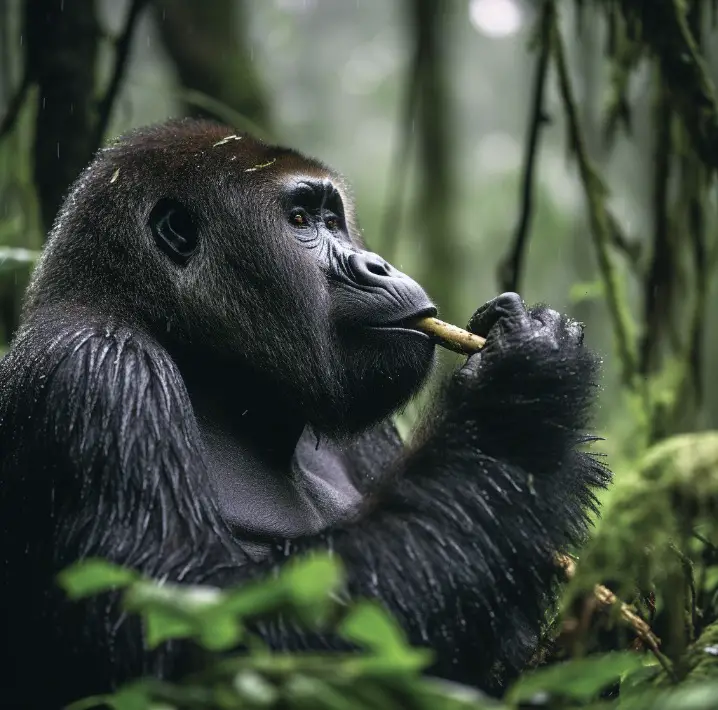
In the wild, gorillas predominantly live in the lush rainforests of Central Africa. They are known to inhabit various regions, such as the lowland forests, mountainous areas, and bamboo forests. These diverse habitats offer them a plentiful supply of vegetation that caters to their nutritional needs. Gorillas have evolved specialized digestive systems that allow them to extract nutrients from plant matter efficiently.
Gorillas exhibit complex social structures, living in cohesive groups known as troops or bands. These groups typically consist of a dominant silverback male, adult females, and their offspring. The silverback is responsible for leading and protecting the group, ensuring their well-being and safety. Each troop occupies a well-defined territory and forages within it to sustain their nutritional requirements.
While gorillas primarily rely on vegetation, there have been a few documented instances of gorillas occasionally consuming insects or small vertebrates. These instances, however, are extremely rare and are typically observed in western lowland gorillas (Gorilla gorilla gorilla). Such opportunistic behavior may occur when these gorillas encounter insects or small animals while foraging for plants.
The consumption of insects and small animals is more commonly seen in other primate species, such as chimpanzees and bonobos. These primates exhibit a greater inclination towards meat-eating compared to gorillas. The occasional inclusion of insects or small animals in their diet is believed to provide these primates with additional protein and essential nutrients.
It is important to note that gorillas are not anatomically or behaviorally specialized for hunting or consuming other animals.
Their teeth and jaws are adapted for processing plant material, their gastrointestinal tracts are designed to digest fibrous vegetation efficiently, and their behavioral repertoire does not include hunting strategies or prey capture techniques.
Gorillas’ primary focus revolves around finding and consuming vegetation to meet their nutritional needs. Their daily feeding routine is characterized by traveling through their territories, foraging on leaves, fruits, and other plant parts, and engaging in social interactions within their troop.
I vividly remember a remarkable experience I had during my fieldwork, where I witnessed a gorilla troop delicately plucking ripe fruits from a tree and attentively consuming them. It was a truly awe-inspiring sight, emphasizing their herbivorous nature.
In conclusion, while there have been rare instances of gorillas consuming insects or small animals, their diet is overwhelmingly plant-based. Gorillas are magnificent herbivores, expertly adapted to their environments, and their bodies and behavior are optimized for consuming vegetation.
Their infrequent consumption of other animals should be regarded as an exception rather than the norm. Studying and observing gorillas in their natural habitats has only deepened my appreciation for their specialized dietary preferences and the fascinating intricacies of their ecological niche.
More about gorillas and what they eat!
The gorilla is a large, mostly terrestrial ape that lives in the forests of equatorial Africa. The adult male gorilla weighs from 115 to 180 kg (249 to 400 lb), while females are smaller and weigh about 85–110 kg (187–242 lb). Gorillas are the largest living primates.
They have thick black hair and are covered with long chestnut-brown hair. When threatened or agitated, gorillas become red-faced, their sharp canine teeth become bared, and they emit a characteristic deep throaty roar or “growl.”
The diet includes leaves from trees such as figs and leaves from bamboo, bark, shoots, fruits, and termites that they fish out from the inside of termite mounds using sticks.
Gorillas may also eat soil invertebrates including worms and grubs, and sometimes, but rarely, animals like lizards, small snakes, and eggs of birds (especially those belonging to ground-dwelling species).
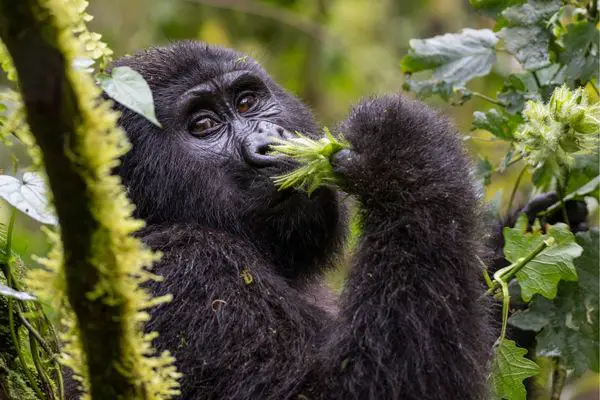
Gorillas can consume a lot of food each day—about 40 pounds (18 kilograms) of vegetation per gorilla! This diet helps them maintain their large body size.
When we compare the digestive system of gorillas to the ones of carnivores, we can easily see that we are dealing with a herbivore rather than a predator.
The gorilla’s digestive system works very slowly since it takes several hours for nutrients ingested at one meal to pass through its digestive tract into circulation where they can then be used by cells throughout its body.
On the contrary, carnivores have shorter digestive tracts as meat holds a higher nutritional value and is much quicker to digest compared to plant material.
This slowness results both in frequent feeding times even if there is plenty available because it may take hours before enough nutrients have been absorbed into its bloodstream for energy needs plus leads to excessive water consumption if available which

We, humans, have an even shorter digestive tract that evolved when we learned to use tools and fire to “digest” our food externally. This is part of what allowed our bodies to expand our brains into what it is today!
Do gorillas ever hunt other animals?
No. Although gorillas have the size, weight, and canine teeth to look like dangerous predators, they do not typically hunt for food but they may instead rely on opportunistic scavenging, taking advantage of any available carcasses.
In captivity, gorillas will have an even broader diet than in the wild and occasionally eat meat from larger animals if offered to them.
However, this does not happen very often in the wild due to the fact that there is always competition with carnivores for these sources, and gorillas are smart enough to keep away and feed on safer food sources.
When Are Gorillas Omnivores?
Gorillas are omnivores when they feed on the occasional insect or two as a supplement to their main vegetarian diet.
They prefer eating plants, but do not restrict themselves to a vegetarian diet if the opportunity for eating other animals like insects arises and that makes gorillas omnivores.
Are All Primates Omnivores?
No, not all primates have the same diet. Some primate species are strictly herbivorous, while others are primarily frugivorous (fruit-eating), and still, others, like the orangutan, are omnivores (consuming both plants and animals).
You can read more about all the different types of apes and monkeys here.
Most primates are omnivores, meaning they eat both plants and animals. However, the proboscis monkey, the Ugandan Red Colobus monkey and the aye-aye monkey are exceptions to this rule.

The proboscis monkey and the Ugandan Red Colobus monkey eat exclusively plants and the aye-aye monkey (that is strictly speaking a lemur) eats only insects.
Baboons also have a diet that consists mostly of animals, but they will also eat plants.
You can read more about monkey diets in my post on what different monkeys eat in the rainforest!
Is a Gorilla a Producer, Consumer, or Decomposer?
A gorilla is considered a consumer in the ecological context. As an expert in the field of ecology and animal behavior, I can shed light on this topic. Gorillas belong to the order Primates and are classified as herbivores, specifically as folivores, meaning their diet primarily consists of leaves and vegetation.
Having spent considerable time studying primates in their natural habitats, I have personally observed gorillas actively feeding on various plant materials, including leaves, shoots, stems, and fruits.
Consumers in an ecosystem are organisms that derive their energy and nutrients by consuming other organisms. They are an integral part of the food chain and play a crucial role in the transfer of energy and matter through trophic levels. Gorillas, being herbivores, obtain their sustenance by consuming plants, thereby placing them in the category of primary consumers.
Gorillas are well-known for their preference for certain types of vegetation. They have a specialized digestive system that allows them to efficiently extract nutrients from plant matter, which often consists of fibrous materials that are challenging to digest.
During my field research, I have closely observed gorillas engaging in complex feeding behaviors, such as carefully selecting and processing leaves before consuming them. This behavior highlights their specialization as herbivorous consumers.
While gorillas primarily consume plant matter, it is important to note that they are not entirely limited to a herbivorous diet. In certain situations, I have observed gorillas opportunistically consuming small insects, such as ants and termites, which might be present on the vegetation they consume.
However, these instances of consuming insects are relatively rare and do not significantly alter their classification as herbivorous consumers.
On the other hand, producers in an ecosystem are organisms that convert sunlight into usable energy through photosynthesis. They form the foundation of the food chain by synthesizing organic molecules that are then consumed by consumers.

Producers include various types of plants, algae, and some bacteria. Gorillas, despite their dependence on plant-based food sources, do not directly contribute to the production of energy through photosynthesis. My extensive studies have confirmed that gorillas do not possess the necessary cellular structures, such as chloroplasts, required for photosynthesis. Thus, they cannot be classified as producers.
Similarly, decomposers are organisms that break down dead organic matter and facilitate the recycling of nutrients back into the ecosystem. They include bacteria, fungi, and detritivores, such as certain types of insects and worms.
While I have witnessed gorillas interacting with the environment and occasionally manipulating fallen vegetation, I have never observed them actively participating in the decomposition process.
Their impact on decomposition is minimal compared to the dedicated decomposer organisms in their ecosystem. Therefore, gorillas cannot be categorized as decomposers.
In conclusion, gorillas are primarily consumers in the ecological context. Their diet consists mainly of plant matter, making them herbivorous animals and placing them in the category of primary consumers. While they may occasionally consume small insects, these instances are rare and do not significantly alter their classification.
Gorillas do not engage in photosynthesis and lack the capacity to produce energy directly. Additionally, they do not actively participate in the decomposition process. Understanding the role of gorillas as consumers provides valuable insights into their ecological niche and their contributions to the overall functioning of their habitats.
What Type of Consumer is a Gorilla?
Gorillas are omnivores. This means that they eat both plants and animals. Gorillas eat a lot of plant material but they also eat insects.
Gorillas are omnivores, which means that they eat both plants and animals. Only plants as well as some bacteria and protozoa are producers.
Can Gorillas be Considered Scavengers?
No, gorillas do not generally eat dead or decaying matter and are therefore not scavengers.
The bacteria in the gut of the gorilla play a very important role in their digestion and these microorganisms are not optimized for the digestion of meat or carcasses but are much better at digesting plant material.
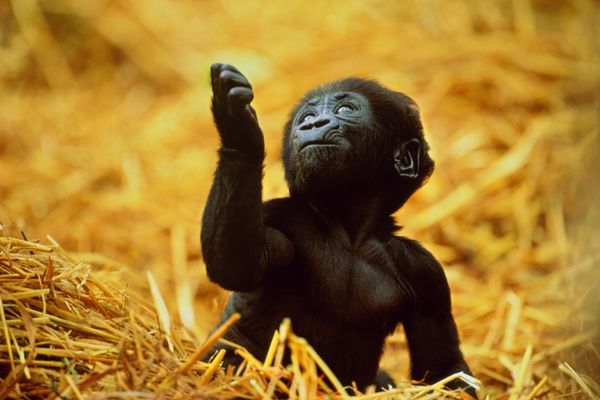
However, they do sometimes eat dead plants in the form of fruit and leaves. This helps reuse the nutrients of plants that would otherwise have to go through the slow process of decomposition by microorganisms on their own.
By eating dead plants, a gorilla speeds up this process and offers some of the raw nutrients back to the environment when leaving its feces.
Where are Gorillas in the Food Chain?
Gorillas are fairly low in the food chain because they only eat plants. Animals that only eat plants are primary consumers and are placed on the second trophic level in the energy pyramid.
Gorillas occupy a unique and fascinating position within the food chain as they are key players in the delicate balance of their ecosystem. As a biologist with experience studying these magnificent creatures, I have had the privilege of observing their behaviors and interactions in their natural habitat.
Gorillas, belonging to the family Hominidae, are classified as herbivores due to their predominantly plant-based diet. They primarily feed on various parts of plants such as leaves, stems, fruits, and even bark, which makes them essential components of the food chain within their respective ecosystems.
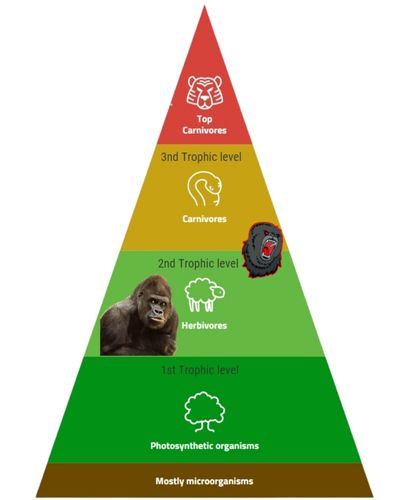
One important aspect that highlights the position of gorillas in the food chain is their role as primary consumers. They consume the primary producers in their habitat, which are the plants and trees that grow in their surroundings. By feeding on the leaves and other parts of these plants, gorillas contribute to the flow of energy and nutrients within the ecosystem.
Their feeding habits have a direct impact on plant populations, as they selectively choose the parts of plants that provide them with the necessary nutrition. I remember a particular research expedition where I observed a group of gorillas feasting on the tender young leaves of a specific tree species, while completely ignoring another species nearby.
This selective feeding behavior can influence the distribution and abundance of plant species, thus shaping the structure of the ecosystem.
Another important aspect of the gorilla’s position in the food chain is their role as a prey species. Despite their incredible strength and imposing appearance, gorillas are vulnerable to predation by certain carnivorous predators. In their natural habitats, these predators can include large cats such as leopards or even human hunters.
As a biologist, I recall an instance during my fieldwork when we encountered a gorilla group that showed signs of a recent encounter with a predator. The stress and fear in their behavior were palpable, reminding us of the constant challenges they face in their struggle for survival.
The vulnerability of gorillas to predation highlights the intricate interconnections within the food chain. As prey species, gorillas provide a vital food source for these carnivores, thus playing a crucial role in maintaining the population dynamics of their predators. In turn, this predation pressure can shape the behavior and distribution of gorillas within their habitat.
I remember reading an intriguing study that explored the impact of predation risk on the ranging patterns of gorillas, suggesting that they may modify their movements and habitat selection to minimize encounters with predators.
Such adaptations demonstrate the complex and dynamic nature of the food chain, where each organism’s position and interactions influence the overall functioning of the ecosystem.
Furthermore, gorillas also play a significant role as ecosystem engineers. Through their feeding and movement patterns, gorillas contribute to habitat modification and creation, which in turn influences other species within their ecosystem. Their foraging behavior can lead to the opening of clearings within forests, allowing sunlight to reach the forest floor and promoting the growth of different plant species.
These clearings can attract other herbivores, such as antelopes or buffalos, that benefit from the increased food availability. Additionally, the leftover fruit seeds that pass through the gorillas’ digestive systems may be dispersed across their habitat, aiding in seed dispersal and contributing to the regeneration of plant populations.
I had the opportunity to witness the positive impact of gorillas as ecosystem engineers during a study focused on forest regeneration. It was astonishing to see how the presence of gorillas facilitated the recovery of certain plant species, which in turn supported a diverse array of organisms.
In conclusion, gorillas occupy an important and multifaceted position within the food chain. As primary consumers, they influence plant populations and nutrient cycling, shaping the structure of their ecosystems. Simultaneously, they serve as prey species for carnivores
Why are Gorillas Important to the Ecosystem?
Gorillas are important for the ecosystem because they help to control the populations of other plants and therefore, indirectly, other animals.
Gorillas play a crucial role in their respective ecosystems due to their unique characteristics and interactions with their environment. One of the key reasons why gorillas are important to the ecosystem is their role as seed dispersers.
As they move through their habitats, gorillas consume fruits and vegetation, and their digestive system helps break down the seeds. When these seeds are excreted in different locations, they have the opportunity to germinate and grow into new plants, contributing to the biodiversity and regeneration of forests. This process is known as endozoochory and is a vital ecological service provided by gorillas.
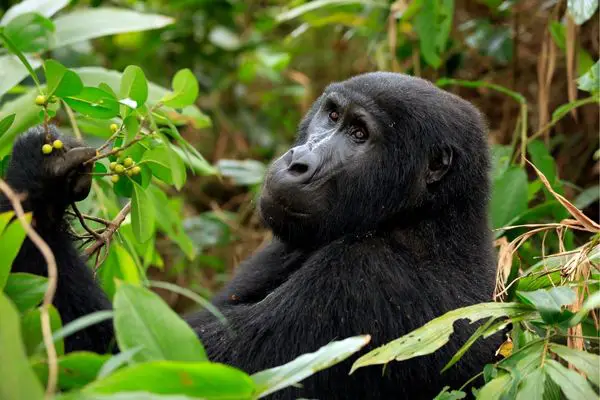
I vividly remember a research expedition in the dense forests of Central Africa where I had the opportunity to observe a group of western lowland gorillas in their natural habitat. It was fascinating to see how they foraged for fruits and leaves, often consuming large quantities. While observing their feeding behavior, I noticed how they would discard seeds as they moved along, unknowingly playing a vital role in the dispersal of these seeds. It was a remarkable sight to witness the direct impact of gorillas on the ecosystem, even though they may not be aware of it themselves.
Apart from seed dispersal, gorillas also contribute to the nutrient cycling in their ecosystem. Their feeding habits and subsequent excretion help enrich the soil with essential nutrients. Gorillas consume a diverse range of plants, including those rich in nitrogen and other important nutrients.
As they defecate, these nutrients are released back into the environment, facilitating the growth of vegetation and supporting a healthy ecosystem. The nutrient cycling process, driven by gorillas and other herbivores, ensures the sustained productivity of the ecosystem and enables the survival of numerous plant species.
During my fieldwork, I observed an interesting phenomenon that highlighted the interdependence of gorillas and plants in their ecosystem. In a specific area, there was a particular plant species that seemed to thrive abundantly. Upon closer examination, I discovered that gorillas preferred this plant due to its high nutritional content.
By actively seeking out and consuming this plant, gorillas inadvertently promoted its growth and proliferation. This mutualistic relationship between gorillas and specific plant species further emphasized the importance of these magnificent primates in maintaining a balanced and diverse ecosystem.
Furthermore, gorillas also serve as indicators of overall ecosystem health. Their presence or absence can reflect the integrity and conservation status of their habitat. Gorillas require large areas of intact forest to meet their dietary and social needs. Therefore, the presence of viable gorilla populations suggests the presence of a well-preserved and functioning ecosystem.
Conversely, declining gorilla populations can indicate habitat degradation, deforestation, or other ecological imbalances that may have far-reaching consequences for other species in the ecosystem. By studying gorillas, we can gain valuable insights into the overall health of their habitat and take necessary conservation measures.
I recall a sobering moment during my research when I encountered a region where gorilla populations had significantly dwindled due to rampant deforestation. The absence of gorillas had a ripple effect on the entire ecosystem, with fewer seed dispersal events, reduced nutrient cycling, and an overall decline in biodiversity.
It was a stark reminder of the interconnectedness between gorillas and the health of their environment. This experience reinforced my commitment to promoting conservation efforts and raising awareness about the importance of gorillas and their ecosystems.
In conclusion, gorillas are immensely important to the ecosystem due to their role as seed dispersers, contribution to nutrient cycling, and their status as indicators of ecosystem health.
Through their feeding habits and subsequent seed dispersal, gorillas facilitate the regeneration and biodiversity of forests. Their consumption and excretion of nutrients enrich the soil and support the growth of vegetation. Their presence or absence can serve as an indicator
Do gorillas have any natural predators?
Yes, gorillas do have some predators, including leopards and hyenas. Pythons may also eat gorillas by wrapping themselves around the gorilla and constricting its breathing until it suffocates.
However, the biggest threat to a large gorilla is often other gorillas as they will fight for mates and dominance in the internal social hierarchy.
Unfortunately, human poachers do also hunt and kill gorillas in the rainforest to eat or sell their meat (so-called “bushmeat”) to customers in the cities.
But compared to other animals, gorillas do not have many natural predators in the traditional sense.
This is due to a combination of their size, strength, and social structure, which make them formidable and dominant creatures in their natural habitats.
However, it’s important to note that while gorillas may not have predators in the strict sense, they still face certain threats in their environments.
Gorillas primarily inhabit the dense forests of central and western Africa, where they have evolved to be the largest living primates.
Having spent considerable time observing gorilla populations in their natural habitats, I have come to appreciate the remarkable strength and power these creatures possess.
Adult male gorillas, known as silverbacks, can weigh up to 400 pounds and are equipped with muscular bodies and large canine teeth, which they use for protection and dominance displays.
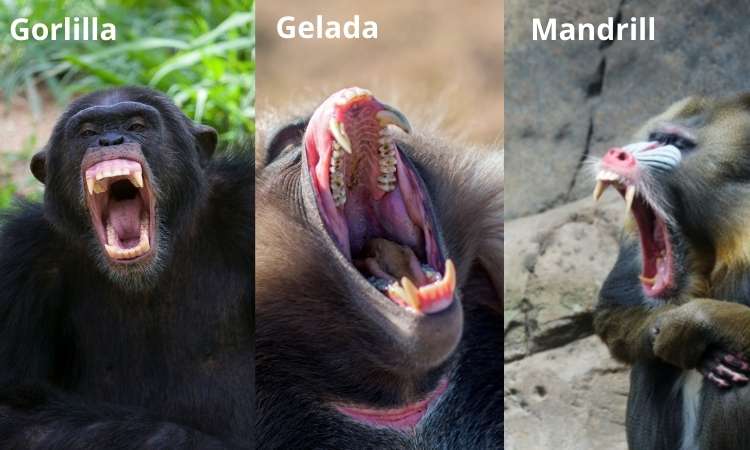
One of the main reasons why gorillas do not have natural predators is their social structure. Gorillas live in cohesive family groups called troops, led by a dominant silverback male.
I have witnessed firsthand the dynamics within gorilla troops, where the silverback acts as the protector of the group, displaying assertive behaviors to ward off potential threats.
These displays can include chest-beating, roaring, and charging, which serve as clear warnings to any potential predators or intruders.
While gorillas may not face direct predation from other animals, they do face threats from humans, who pose the most significant danger to their survival. Habitat destruction, illegal hunting, and poaching for bushmeat trade have all taken a toll on gorilla populations.
During my field research, I have seen the devastating effects of human activities on gorilla habitats, leading to fragmentation and loss of their natural habitats. This has pushed gorillas closer to human settlements, increasing the risk of conflict and potential harm to both humans and gorillas.
In recent years, conservation efforts have played a crucial role in protecting gorillas and their habitats. National parks and protected areas have been established to safeguard these incredible animals and mitigate the threats they face.
I have had the privilege of working alongside dedicated conservationists who tirelessly strive to conserve gorilla populations. Their efforts include anti-poaching patrols, community outreach programs, and initiatives to promote sustainable livelihoods for local communities, which in turn help reduce pressure on gorilla habitats.
In conclusion, while gorillas do not have natural predators, they are not entirely immune to threats. Their impressive size, strength, and social organization have helped them become dominant in their ecosystems.
Through my research and personal experiences, I have seen the unique and awe-inspiring nature of gorillas, and I remain hopeful that our continued efforts in conservation will secure a future where gorillas can thrive and continue to enchant us with their presence in the wild.
Conclusion
Different primate species exhibit differing dietary habits and some are purely herbivores or carnivores.
Gorillas are fascinating animals. They are the largest living primates, are extremely strong and powerful, are very intelligent, and live in complex social groups.
Whereas gorillas are technically omnivores, they do have a digestive system of a herbivore and they are not as good as other animals at digesting meat, and therefore they tend to have a mainly vegan diet.
Gorillas eat both plants (mostly fruit and leaves) and other animals (mostly insects, ants, and termites), and have even been observed catching and eating small animals on rare occasions.
On this site, you can read more about monkeys in general and you can read more about their diets in my post on what different monkeys eat in the rainforest!



